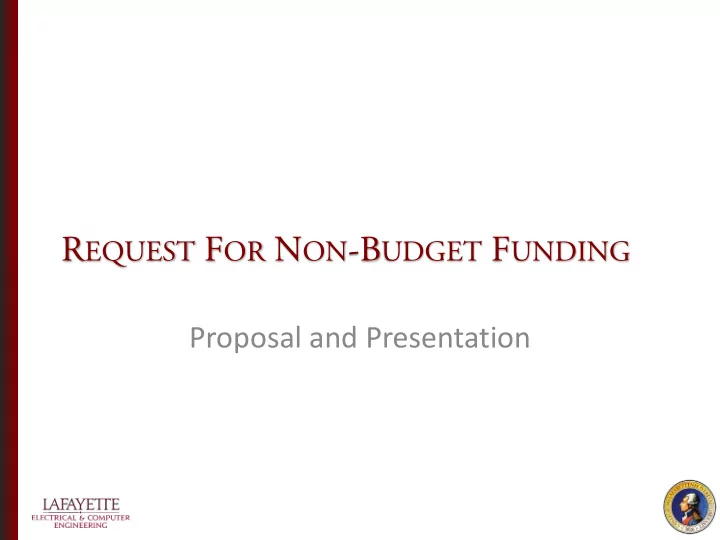

R EQUEST F OR N ON -B UDGET F UNDING Proposal and Presentation
M OTOR - HPEVS AC 5X 27.28 Weight: 85 lbs. Horsepower: 71 hp Torque: 120 ft.-lbs. Voltage: 72-108 V Current: 550-650 A Max RPM: 6500 rpm
M OTOR P OWER G RAPHS
M OTOR S IMULATION • Motor model designed in Simulink. • Simulation derived from Kevin Schmid’s model during the 2013 project. • Adapted for use with HPEVS AC-50 Induction motor. • Used lookup tables along with graphs from manufacturer to derive motor behavior
S IMULINK D IAGRAM
S IMULATION G RAPHS
S IMULATION G RAPHS
M OTOR C ONTROLLER - C URTIS 1238R Max Power Rating (2 min): 73.6 kVA RMS Voltage: 72-96 V Max Current: 650 A RMS Torque: 115 ft. lbs.
M OTOR AND C ONTROLLER W IRING D IAGRAM
D YNAMOMETER - H UFF HTH-100 Power: 120 VAC @ 10 A (standard wall outlet) Torque Capacity: 150 ft. lbs. Max RPM: 11250 rpm Water Use: Self Contained
P OWER S UPPLY – M AGNA P OWER TSD100- 250/208 DC programmable power supply Can use outlet already installed in • • room 401 Output: 0-100 Vdc; 0-250 Adc; • 25kW Provides necessary ranges to • operate motor at realistic power Digital front panel for ease of use •
T EST S TAND & T ESTING P LAN MCS and Test Stand Test Plan: MCS and Test Stand Verification - This test will verify correct operation of motor while connected to a dynamometer on a test bench. It will verify the motor, motor controller and dynamometer are all functional. Preconditions: • Motor and dynamometer are each securely mounted to test bench. Motor and dynamometer are connected (if test requires dynamometer). • Motor is connected to motor controller, which is plugged into a power supply. • Area is prepared for safe operation of motor - all loose items are out of 15 safety area. • Expected results from test are read aloud including maximum expectations for RPMs and Torque so everyone knows when safe conditions have been exceeded. Test Procedure: • Turn on power supply to motor controller. • Set-up any necessary configuration parameters on motor controller. • Apply acceleration signal to motor and observe motor turning. • Read data from display of dynamometer for more details. • Turn off power supply and unhook from motor controller.
W HAT W ILL T HIS C OST HPEVS AC 50 Motor Kit w/ Curtis 1238R Controller = $4,150 Huff HTH-100 Dynamometer = $9,975 TSD100-250/208 PSU = $15,115 Installation and Matainance = $5,000 Total = $29,240 Budget Request: $35,000 Other possible costs: • Water pump for extensive testing • Dedicated 120VAC main circuit • Pipes for dynamometer • Installation / Maintenance costs
W HERE T HIS W ILL G O / W HO IS IN CHARGE • Room 401 has provided 208 Vdc 3-phase outlet required for power supply. • Dynamometer is self contained and does not required external cooling. • Can be stored in Room 401 when not in use. Has no student access. • The ECE department has agreed to take responsibility for the assembly.
W HY W E N EED I T • Proper pack testing requires realistic load (i.e. the proposed motor) • To further along the LFEV progress must be made. Purchasing the motor is a large milestone • Next years team has a lot of work to do. Purchasing the motor assures they will have time to test it and design the car around it. • This project proposes many obstacles towards its completion. We’d like to eliminate this one.
W HY W E C AN ’ T W AIT • Time is of the essence. As soon as the pack is ready, it needs to be tested under realistic load. • Last years team picked out a motor and controller. If we don’t make the purchase this semester, next years team will have to waste valuable time doing work that has already been done. • The LFEV would like to compete in 2015. This motor has to be purchased now if that will become a reality.
W HY I T ’ S I N O UR S COPE • Both the motor and controller are electrical components. Knowledge about both of those things are gained in ECE classes. • Testing the motor requires an electrical input which can be best provided within the ECE department. • As much as possible should be studied about the motor before integration with the chassis, especially the electrical parameters.
W HAT WE ’ RE ASKING FOR $35,000 to cover the full cost of: • Motor and Controller • Test stand and dynamometer • Power Supply • Parts required for assembly and upkeep • Potential Installation costs • PC dedicated to test stand (data acquisition)
W EBSITES HPEVS AC 5X 27.28 - http://www.electriccarpartscompany.com/ • Huff HTH-100 - http://www.huff-tech.com/ • Curtis 1238R - http://curtisinstruments.com/ • Magna Power TSD100-250/208 - http://www.magna-power.com/ •
Recommend
More recommend